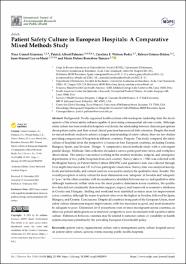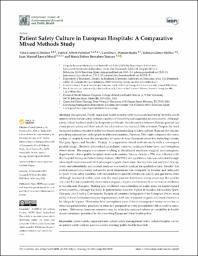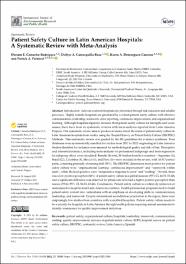Patient Safety Culture in European Hospitals: A Comparative Mixed Methods Study

View/
Download
(application/pdf: 773.0Kb)
(application/pdf: 773.0Kb)
Date
2022-06-14Author(s)
Granel-Giménez, Nina
Albert Palmieri, Patrick
Watson-Badi, Carolina E.
Gómez-Ibáñez, Carolina E.
Leyva-Moral, Juan Manuel
Bernabeu-Tamayo, María Dolors
Metadata
Show full item recordAbstract
“Background: Poorly organized health systems with inadequate leadership limit the development of the robust safety cultures capable of preventing consequential adverse events. Although
safety culture has been studied in hospitals worldwide, the relationship between clinician perceptions
about patient safety and their actual clinical practices has received little attention. Despite the need
for mixed methods studies to achieve a deeper understanding of safety culture, there are few studies
providing comparisons of hospitals in different countries. Purpose: This study compared the safety
culture of hospitals from the perspective of nurses in four European countries, including Croatia,
Hungary, Spain, and Sweden. Design: A comparative mixed methods study with a convergent
parallel design. Methods: Data collection included a survey, participant interviews, and workplace
observations. The sample was nurses working in the internal medicine, surgical, and emergency
departments of two public hospitals from each country. Survey data (n = 538) was collected with
the Hospital Survey on Patient Safety Culture (HSOPSC) and qualitative date was collected through
24 in-depth interviews and 147 h of non-participant observation. Survey data was analyzed descriptively and inferentially, and content analysis was used to analyze the qualitative data. Results: The
overall perception of safety culture for most dimensions was ‘adequate’ in Sweden and ‘adequate’
to ‘poor’ in the other countries with inconsistencies identified between survey and qualitative data.
Although teamwork within units was the most positive dimension across countries, the qualitative data did not consistently demonstrate support, respect, and teamwork as normative attributes
in Croatia and Hungary. Staffing and workload were identified as major areas for improvement
across countries, although the nurse-to-patient ratios were the highest in Sweden, followed by Spain,
Hungary, and Croatia. Conclusions: Despite all countries being part of the European Union, most
safety culture dimensions require improvement, with few measured as good, and most deemed to
be adequate to poor. Dimension level perceptions were at times incongruent across countries, as
observed patient safety practices or interview perspectives were inconsistent with a positive safety
culture. Differences between countries may be related to national culture or variability in health
system structures permitted by the prevailing European Union health policy.“
Collections
- Web of Science (WOS) [236]
Related items
Showing items related by title, author, creator and subject.
-
Patient Safety Culture in European Hospitals: A ComparativeMixed Methods Study
Granel-Giménez, Nina; Palmieri, Patrick Albert; Watson-Badia, Carolina E.; Gómez-Ibáñez, Rebeca; Leyva-Moral, Juan Manuel; Bernabeu-Tamayo, María Dolors (MDPI, 2022-01-14)Acceso abiertoBackground: Poorly organized health systems with inadequate leadership limit the devel-opment of the robust safety cultures capable of preventing consequential adverse events. Althoughsafety culture has been studied in ... -
Patient Safety Culture in Latin American Hospitals: A Systematic Review with Meta-Analysis
Camacho-Rodríguez, Doriam E; Carrasquilla-Baza, Deibys A; Dominguez-Cancino, Karen A; Palmieri, Patrick A (MDPI, 2022-11-03)Acceso abierto“Introduction: Adverse events in hospitals are prevented through risk reduction and reliable processes. Highly reliable hospitals are grounded by a robust patient safety culture with effective communication, leadership, ... -
Patient Safety Culture in Latin American Hospitals: A Systematic Review with Meta-Analysis
Camacho-Rodríguez, Doriam E; Carrasquilla-Baza, Deibys A; Dominguez-Cancino, Karen A; Palmieri, Patrick A (MDPI, 2022-11-03)Acceso abierto“Introduction: Adverse events in hospitals are prevented through risk reduction and reliable processes. Highly reliable hospitals are grounded by a robust patient safety culture with effective communication, leadership, ...




